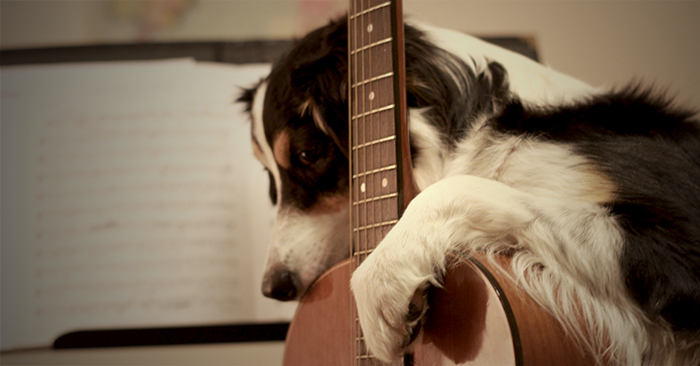
The idea of teaching improvisation in the music classroom intimidates many music educators, and for good reason. When young musicians struggle to read music on the page it seems like a ridiculous leap to have them create music spontaneously!
In practice it’s easy, really. You just have to work like a dog.
In earlier blogs, I shared some positive reinforcement methods I use in training my dogs, Cooper and Pip, that will also help your students learn without mistakes, overcome stage fright, and develop good classroom habits. Here, I’ll share a few different ways for you to teach your young musicians to improvise confidently in the music classroom.
We can break this down into two basic techniques: learning within boundaries and free shaping. Learning how to improvise effectively requires a combination of both.
Learning Within Boundaries
Giving students (and dogs) strict boundaries in the learning process may at first seem counter-intuitive for creative performance. Surprisingly, it actually helps students achieve success early and often, leading to more confident performances later on.
When I first tried teaching Cooper to back up, I’d have him face me as I walked towards him slowly. Sometimes he’d take a couple steps back when I got close. Success! Other times, he’d sidestep to get out of the way then give up in frustration when he wasn’t rewarded.
I knew I needed to make a change in order for him to experience more consistent success. Eventually, I simplified the exercise for Cooper. I set up a narrow passageway through which he could move only forward or backward – sidestepping wasn’t an option. No surprise, he performed beautifully when his options were limited. Gradually, I expanded the passage, practicing success every step of the way until he figured out exactly how to back up with no boundaries around at all.
Improvising Is Scary
Learning to improvise is similar in that it can feel totally overwhelming to a beginner. Think of it like this: they’re frantically trying to mix and match all of the notes they know with all of the rhythms they know in the span of four whole measures! Even if you’re sticking with just one chord through the phrase, the possibilities are seemingly endless.
Let’s break it down further:
- Major chord: (3) notes
- Beginner’s range: (2) octaves
- Measures: (4)
- Possible rhythms: sixteenths, eighths, quarter notes, half notes, whole notes, eighth-note triplets (6)
A student could choose to play the same four whole notes. More likely, they’ll panic through one of the (much) more than 1,440 possible combinations of those notes.
Set Boundaries + Simplify the Process
Make the process less scary by simplifying. Instead of giving them four whole measures to experiment with, start one measure at a time. Limit their options. You might ask them to play only a B-flat in the staff using various rhythms. Or you might request that they play only half notes using pitches in the B-flat major chord. You get the idea.
Setting stricter boundaries simplifies the exercise so students can experience success and gain confidence faster. You can also implement this idea with simple ear-training exercises to help students familiarize themselves with the feel of common chord progressions. By changing the boundaries you set, improvisation becomes less of an exercise in music theory and more fun.
With practice, students become more and more comfortable improvising in different scenarios because they have a feel for what “works.”
Free Shaping
Developing basic improv skills is half of the challenge. The other half is developing the confidence to perform creatively in front of an audience. This is perhaps the harder part, but it’s easy to address with a method called free shaping.
We do this with dogs using a really great game called “101 Things to Do with a Box.” I started playing this game with Pip when he was just a couple months old. To play, I’d put a box in the middle of a room and sit against a wall with a cup of kibble. I ignored Pip completely until he first looked away from me and to the box. As soon as he looked at the box, he got a treat. He learned that looking at the box equaled a treat. Eventually I raised the criteria for a treat to walking over to the box, then putting his paws on the box, then grabbing it, etc. Once he’d mastered a few useful and entertaining behaviors (flipping the box onto himself, carrying it around a room, and jumping on top), I gave each trick a unique name so he could repeat them on cue.
The exercise rewards a dog for thinking creatively using positive feedback and no boundaries. It also builds lots of valuable new skills along the way.
An Exercise in Creative Improvising
We can apply free shaping in the music classroom similarly.
To start, put on a few tracks by free jazz artists like Albert Ayler, Ornette Coleman, or John Zorn: the crazier the better. Allow students the opportunity to hear jazzers known for their unconventional creativity.
Then, have students sit in a circle and ask each to play a 30 second free solo over a continuous rhythm track, with the solo getting “passed” from one student to the next. Emphasize that there are no “bad” notes and rhythms and that their job is to have fun.
The most important part: encourage listening students to clap, stomp, hoop, and holler whenever the soloist plays something they like, whether that be a funky rhythm, melody, or tone. Not only does this keep all of your students listening and engaged, it also keeps them from worrying about what they’re going to play when it’s their turn to solo. Channeling the energy of young musicians in a fun, productive setting is just an added bonus.
Behavioral Momentum
Exercises like this work so well because they often lead to something we call “behavioral momentum.” Behavioral momentum occurs when students (who feel successful early in the learning process) become more resilient when faced with harder and harder tasks.
Create a high-energy, wildly supportive atmosphere in the classroom and your students will likely surprise you with how quickly they start to learn and adapt on their own.
Balance is Always Better
As much as we’d all love to have a classroom full of just theory whizzes or just free jazzers, we should strive instead to have students who can do both. Set boundaries to develop basic skills, then use free shaping to help students perform creatively and confidently. By alternating between the two, you empower them to grow into artists and musicians rather than just performers.
When you see just what your students can do with some practice, you’ll be like a dog with two tails!
 MakeMusic’s conversion marketing manager, Kait Creamer works to share SmartMusic and Finale with musicians around the world. She received her B.M. in music industry with a concentration in tuba from Middle Tennessee State University. Kait currently plays in the Gunbarrel Brass Quintet.
MakeMusic’s conversion marketing manager, Kait Creamer works to share SmartMusic and Finale with musicians around the world. She received her B.M. in music industry with a concentration in tuba from Middle Tennessee State University. Kait currently plays in the Gunbarrel Brass Quintet.
Inspired by work with herding dogs in New Zealand, she returned stateside to train two Australian Shepherds, Cooper and Pip. They are often seen doing tricks for popcorn at the MakeMusic office in Boulder, CO.